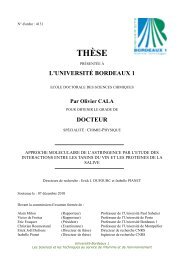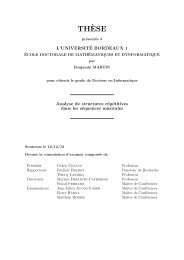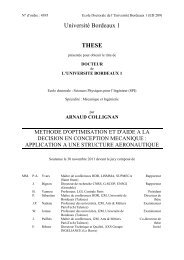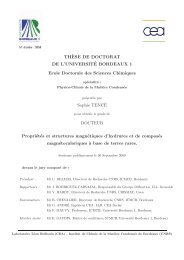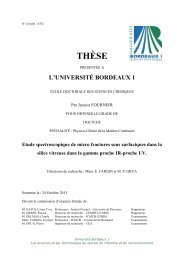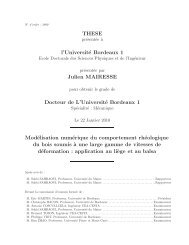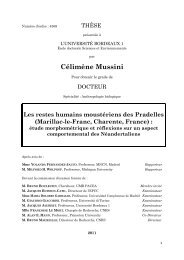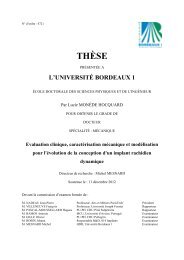de la structure à la croissance cellulaire - Université Bordeaux 1
de la structure à la croissance cellulaire - Université Bordeaux 1
de la structure à la croissance cellulaire - Université Bordeaux 1
You also want an ePaper? Increase the reach of your titles
YUMPU automatically turns print PDFs into web optimized ePapers that Google loves.
106 M. Bourdon et al.<br />
Fruit growth relies on a spatially and temporally organized pattern of cell<br />
division and of cell expansion. Remarkably, fleshy fruit tissues may have very<br />
various ontogenic origins (Coombe 1976), although they all share simi<strong>la</strong>r characteristics,<br />
with <strong>la</strong>rge, highly vacuo<strong>la</strong>ted cells with thin walls. In tomato, the ovary<br />
wall has seemingly a simple organization at anthesis, with ca. 11 <strong>la</strong>yers of small<br />
isodiametric cells including two epi<strong>de</strong>rmal cell <strong>la</strong>yers, and vascu<strong>la</strong>r bundles in the<br />
central pericarp (Cheniclet et al. 2005). During fruit organogenesis and growth, the<br />
fertilized ovary acquires a complex pattern of cells with various sizes and shapes,<br />
and various metabolic differentiations (Cheniclet et al. 2005; Gil<strong>la</strong>spy et al. 1993;<br />
Mohr and Stein 1969; Smith 1935) (Fig. 1a). How this spatio-temporal pattern of<br />
<strong>de</strong>velopment is re<strong>la</strong>ted to gene expression, metabolic profiles and cellu<strong>la</strong>r characteristics,<br />
such as endopolyploidy has only just started to be <strong>de</strong>scribed (Lemaire-<br />
Chamley et al. 2005). This apparent slow progress has been due to the difficulty in<br />
corre<strong>la</strong>ting various cellu<strong>la</strong>r and molecu<strong>la</strong>r data at the level of given cell types in<br />
three-dimensionally complex organs, such as fruits. How this complexity re<strong>la</strong>tes to<br />
hormonal and nutritional regu<strong>la</strong>tion during fruit growth also remains <strong>la</strong>rgely ignored.<br />
Many data have been reported on the kinetics of hormone content in various<br />
fruit materials (reviewed in Gil<strong>la</strong>spy et al. 1993; Srivastava and Handa 2005), but<br />
their use for a proper un<strong>de</strong>rstanding of their action in re<strong>la</strong>tion to growth mechanisms<br />
remains rather elusive. Fruit growth requires the combined presence of several<br />
growth-promoting p<strong>la</strong>nt hormones, such as auxin, gibberellins, cytokinins and<br />
brassinosteroids (Cowan et al. 2005; Ozga et al. 2002; Srivastava and Handa<br />
2005). Many of these hormones appear to originate from the <strong>de</strong>veloping seeds,<br />
with a particu<strong>la</strong>r role for the endosperm in the secretion of these compounds.<br />
2.3 Cell Division During Fruit Growth<br />
Active cell division within the flesh is usually restricted to an initial period of<br />
1–2 weeks after pollination and fertilization (e.g., cucurbits, tomato), 3 weeks in<br />
apple, 4–7 weeks in Japanese pear, peach, and plum. Cell divisions do not occur in<br />
the pericarp of Corynth grape, Rubus, or some Ribes species. However, divisions<br />
continue in avocado and in strawberry throughout the life of the fruit (Coombe<br />
1976; Crane 1964; Nitsch 1965). In tomato and as in many fleshy fruits, cell<br />
divisions occur in various cells and with various division p<strong>la</strong>nes to allow fruit<br />
growth, but they also occur in discrete cell <strong>la</strong>yers with <strong>de</strong>finite division p<strong>la</strong>nes for<br />
specific purposes. This is the case for tomato, where the two epi<strong>de</strong>rmal cell <strong>la</strong>yers of<br />
the pericarp un<strong>de</strong>rgo anticlinal divisions, whereas the two subepi<strong>de</strong>rmal <strong>la</strong>yers<br />
un<strong>de</strong>rgo several rounds of periclinal divisions leading to an increase in the number<br />
of pericarp cell <strong>la</strong>yers to a varying extent according to the tomato line. These<br />
various types of cell divisions are differently regu<strong>la</strong>ted because cell-<strong>la</strong>yer<br />
forming cell divisions occur only within 5–8 days post-anthesis in various tomato<br />
lines (Cheniclet et al. 2005; Cong et al. 2002; Mazzucato et al. 1998), whereas



